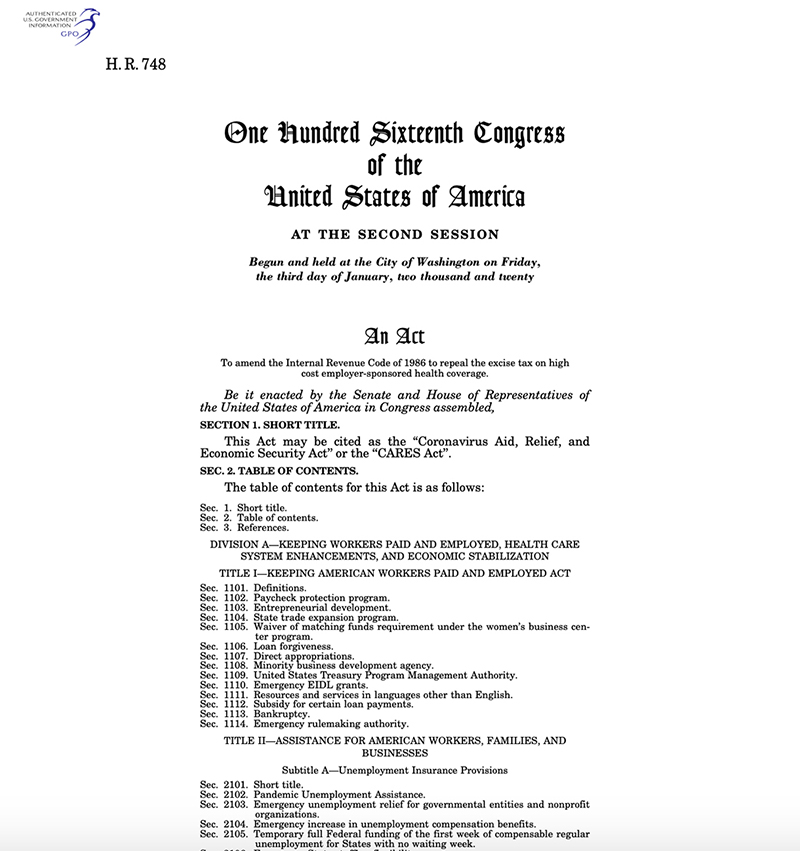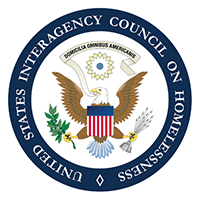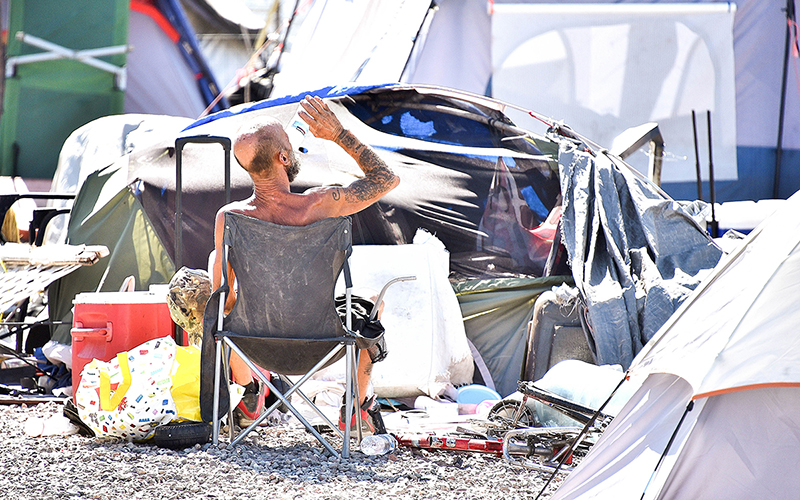This story was supported by the Pulitzer Center.
Four months after Congress rushed $4 billion to help the nation’s homeless population cope with the COVID-19 pandemic, most of those funds still have not made their way to local communities, the Howard Center for Investigative Journalism found, and even those with access to the money have yet to receive federal guidelines on how it can be spent.
The head of one homeless nonprofit in Florida, a state with one of the highest COVID-19 infection rates, said the delay means that some people are living on the street when they could have been housed.
Behind the scenes, meanwhile, advocates for the homeless worry that top officials in the federal government are working to dismantle long-standing policy on permanent housing as the first step to addressing the needs of homeless people. Such a move, they fear, could leave large numbers of vulnerable people ineligible for help.
The Howard Center analyzed federal government data related to the Coronavirus Aid, Relief, and Economic Security, or CARES, Act to understand how much money had reached communities after hearing complaints about delays in homeless funding.
As of early August, the Howard Center found, the U.S. Department of Housing and Urban Development had given communities access to less than one-third of the $4 billion provided by the CARES Act. Cities and counties can access the funds directly or seek reimbursement for approved expenditures after signing grant agreements with HUD.
“Communities across the country are struggling to meet the needs of people who are enduring the pandemic and homelessness, with too many people still unsheltered and at risk of COVID,” said Barbara Poppe, a nationally recognized homelessness expert and former government official. “Unfortunately, the federal funds intended to help meet local needs … are lagging.”
By the time the money snakes its way from the Treasury through HUD, state and local governments, political actors at all levels will have had their say on what they think is best for a population of Americans who are mostly invisible in the halls of power.
‘More than a bit of delay’
The CARES Act’s homelessness funds are meant to help people who are on the streets or in shelters, as well as those on the cusp of homelessness, protect themselves from COVID-19, the disease caused by the novel coronavirus.
HUD provides cities, states and counties with access to those funds to pay, or reimburse, local providers for shelter and other services. It uses a two-tiered system in which big cities and counties have direct access to their share of the funding, while money for rural and smaller communities flows through state governments.
The federal housing agency has told larger jurisdictions how much they could expect to receive from the CARES Act, allowing them to start planning. But smaller jurisdictions and rural counties must wait on their states to tell them how much funding they have to work with – an extra bureaucratic step that burdens smaller communities already overwhelmed by the pandemic.
As of Aug. 7, HUD had finalized grant agreements for only about 29% of the funds, according to a Howard Center analysis of government expenditures from the federal website USAspending.gov and HUD’s designated list of recipients. As a result, most of the relief funds can’t be made available to homeless service providers, who have been working for months in a climate of scarcity and uncertainty.

The CARES Act, a $2 trillion COVID-19 relief bill passed by Congress on March 27, earmarked $4 billion for HUD’s Emergency Solutions Grant program to help homeless people. (Source: Congress.gov)
“We’ve been talking about it for two months and haven’t seen anything,” Rob Cramp, whose organization Housing for the Homeless provides shelter and services in Brevard County, Florida, said in early July. There’s been “more than a bit of a delay,” he said.
At that time, he said there were 50 to 60 people either on the street or in temporary shelters waiting for the federal dollars that would help them move into permanent housing.
In late July, Cramp said he had just learned how much Brevard County had been allocated, but he still didn’t have access to the money and couldn’t move any of those living on the street into shelters or housing. Brevard County is a HUD jurisdiction that gets its funds by way of the state, not directly.
Washington state, which was one of the first areas of the country impacted by the coronavirus, didn’t wait for federal funds. In March, it released $30 million of its own for quarantine and isolation with a specific focus on the homeless population, according to Tedd Kelleher, the senior managing director of Housing Assistance in the state Department of Commerce.
“I can imagine being frustrated if we had to wait for the HUD dollars,” Kelleher said. “We weren’t in a crunch where people didn’t have resources to address the need right in front of them.”
The state has received nearly $10 million but is still waiting on $46 million.
King County, home to Seattle, received access to a portion of its HUD funding and expects to receive the rest in September, according to Sherry Hamilton, the county’s communications director.
“It is certainly true that many in our community are in need of services and assistance far beyond our capacity to respond, so being able to deploy resources as quickly as possible is important,” she said.
Adding to the uncertainty is the fact that HUD has yet to issue guidelines on how these dollars can be spent. Communities are responsible for ensuring grants are spent properly and could be forced to pay back money if HUD later determines it was incorrectly spent.
“It took five months and we’re still not entirely clear about the guidance,” said Bill Faith, executive director of the nonprofit Coalition on Homelessness and Housing in Ohio. “This was supposed to be fast. It was supposed to be expeditious.”
HUD did not respond to Howard Center inquiries about the delays.
In Pinellas County, Florida, one of the large jurisdictions funded directly through the Treasury, officials were able to start planning immediately after HUD announced its funding awards in April and June. But the county delayed action “for a few weeks,” expecting that HUD guidelines would be forthcoming. It finally moved ahead with plans and, as of early August, still had not received any guidelines, said Brook Gajan of the county’s housing and community development department.
When the money does arrive, not all of it will go to homeless people. Under the CARES Act, each level of state and local government that handles the funds takes a cut ranging from 6% to 10% for administrative purposes. Additionally, HUD reserved $40 million for itself to provide technical assistance to recipients of the funds.
Once communities are fully funded, some policy experts fear local governments will direct the majority of the money to homeless prevention, helping people stay in their homes rather than assisting those currently without housing.
“Local governments may want to use it all for prevention … leaving people who are actually literally homeless at the bottom,” said Amanda Rosado, team director of Ending Homelessness, a program of the Florida Housing Coalition.
Ann Oliva, HUD’s former deputy assistant secretary for special needs, said it was “politically and operationally easier to focus on eviction prevention for people who are in housing, and who are, unfairly, often seen as more worthy of assistance than people who are experiencing homelessness.”
But, she added, “We have to do both.”
Politicizing homelessness
Robert Marbut is the executive director of the U.S. Interagency Council on Homelessness, which coordinates the federal government’s responses. Before his appointment in December, Marbut was a housing consultant who promoted certain policies – such as requiring homeless people to meet benchmarks to achieve housing – that stand in contrast to the government’s Housing First model of nearly two decades.
Several former government officials and homeless professionals interviewed by the Howard Center said they worry Marbut is prioritizing a political agenda on the homeless and that he, along with allies in HUD, could affect the way COVID-19 assistance is spent.

Robert Marbut, the executive director of the U.S. Interagency Council on Homelessness, works with federal, state and local officials to coordinate the federal government’s response to homelessness. (Source: U.S. Interagency Council on Homelessness)
“He seems to have an agenda that, as far as I can tell, is more ideological than it is actually based in any kind of research, and that’s very concerning,” said Stephen Metraux, an academic with the nonprofit Center for Evidence-Based Solutions to Homelessness, who has researched government policy on homelessness for 25 years.
In a July report to Congress, Marbut’s interagency council said there had been 130 deaths of homeless people and 4,845 COVID-19 infections, although the report noted the numbers were “provisional” and may “increase slightly.” But it also noted the numbers were lower than projected and that its conclusions were based on “information from data, doctors, epidemiologists and the scientific community.” Footnotes in the report indicated the data came from the U.S. Centers for Disease Control and Prevention, the nation’s lead public health agency.
But an epidemiologist who is the CDC’s senior adviser on homelessness told the Howard Center the agency had no role in developing or reviewing the Interagency Council on Homelessness’ report.
“We don’t have a very precise count of total (homeless) cases. And we expect that the estimates that we do have are an underestimate,” Emily Mosites said.
The Howard Center tracked 153 homeless deaths in the same time period – about two-dozen more than in Marbut’s report to Congress – in just six cities and counties with large homeless populations.
“I am extremely suspect of their data and conclusions,” said Poppe, who served in Marbut’s position during the Obama administration. “It doesn’t look to me like the data they’re getting is going to be solid because homelessness is always undercounted.”
Bobby Watts, the chief executive of the National Health Care for the Homeless Council, said it was possible Marbut’s agency was using “data that suits their political agenda to make this situation look better so it doesn’t make them and their government look worse.”
A day after Marbut’s report was released, a senior HUD advisor cited it in arguing against using empty hotel and motel rooms to isolate at-risk homeless people – a practice employed around the country to reduce the number of people in cramped shelters, where the coronavirus can easily spread.
Paul C. Webster, a senior policy advisor in HUD’s Los Angeles field office, told colleagues he had “encouraged Robert to highlight the low prevalence rate and low number of deaths among people experiencing homelessness,” according to a July 7 email obtained by the Howard Center. He said the number of reported infections and deaths among homeless people “mitigate against the rush to house PEH (people experiencing homelessness) in non-congregate shelters such as hotels and motels.”
Webster said the report showed that converting hotel and motel rooms for homeless people had “nothing to do with COVID and everything to do with the inability of communities” to develop permanent housing options, especially in high-rent areas.
“I think we should talk to all of our journalist friends and highlight this report and that it does not support the rush to use hotels and motels as a solution to homelessness,” Webster said.
Marbut, in a July 15 interview with the Howard Center, indicated he agreed with Webster, saying even during the pandemic, group shelters were superior to individual hotel rooms as long as CDC guidelines on hygiene, social distancing and increased staffing were followed. The CDC promotes the use of hotels and motels as options for homeless people during the pandemic.
“The ability to have an organized response inside a shelter with 24-7 staffing, often with medical staff on-site … there’s no way you can do that when you send six people to one hotel, 50 people to another. The proof is in the numbers,” Marbut said, referring to his July report to Congress.
Marbut’s three predecessors criticized his position, saying the use of hotels and motels has proven critical to saving lives.
One of them, Laura Zeilinger, served in the Obama administration and is now the District of Columbia’s top human services officer.
“What I’ve seen is those services are organized and that people are so much more able in a less chaotic environment to engage in services,” said Zeilinger, who oversees a program that cares for vulnerable members of D.C.’s homeless community in hotels.
Housing first or last?
Since Marbut’s December 2019 appointment as the nation’s homelessness czar, experts say he and his allies at HUD have been engaged in a power struggle over continuation of Housing First.
Adopted in 2004 by the George W. Bush administration, the policy holds that there should be no barriers to housing homeless people and that addictions or other mental health issues are easier to address once people are safely housed and have their basic needs met.

The U.S. Interagency Council on Homelessness is an independent agency within the executive branch, authorized by Congress. (Source: U.S. Interagency Council on Homelessness)
“If you lower the barriers to housing and support, people actually get indoors and want better for themselves,” said Va Lecia Adams Kellum, president of St. Joseph Center, a Los Angeles organization that provides housing and medical and mental health services.
Recipients of HUD grant money are incentivized to use Housing First programs, which independent research has shown to result in long-term housing stability.
Marbut in the past has supported programs that require homeless people to meet benchmarks, such as passing drug tests, before being given access to shelter, housing and other resources. In an interview, he said homeless people should get housing vouchers only if they participate in such programs as job training and counseling.
Proponents of this approach, including Syracuse University researcher David Lucas, say federal funding should support a diverse array of programs because the experiences and backgrounds of homeless people vary.
“There are some for whom homelessness is brief and non-recurring. And there are some who are … experiencing a kind of cycle where they will become homeless again and again, which is very sad,” Lucas said.
In his first official statement as executive director of the interagency council, Marbut questioned existing HUD policy, saying, “If it were working, the number of individuals and families experiencing homelessness would be dropping.”
From 2007 to 2016, HUD data show, the nation’s homeless population decreased by about 15%. From 2016 to 2019, increases in California and a few other states offset decreases in the rest of the nation, contributing to an overall rise.
In its 2020 appropriation for HUD, Congress restricted the agency’s ability to roll back Housing First incentives, but the pandemic has created a new window of opportunity for opponents.
Recognizing the need to quickly supply communities with funds, Congress wrote into the CARES Act a mechanism that allows HUD Secretary Ben Carson to waive many statutory or regulatory requirements related to HUD’s homeless assistance dollars. Although Carson has publicly supported Housing First, he, like Marbut, has called for more local control.
Matthew Doherty, who was executive director of the interagency council in both the Obama and Trump administrations, said he fears that HUD will write guidelines that roll back existing priorities, adding, “I think it’s extremely dangerous.”
Webster, the HUD official who urged colleagues to publicize the low number of homeless deaths and infections, has a record of criticizing Housing First, saying it “handcuffs” local entities from pursuing local solutions to homelessness.
Oliva, the former HUD official, said she worries there will be a move to “create barriers to housing for the very people who need it the most, based on arbitrary and biased standards.”
“This is deeply scary to me,” she said. “It should be to others as well.”
This project was supported by the Pulitzer Center and produced by the Howard Center for Investigative Journalism at Arizona State University’s Walter Cronkite School of Journalism and Mass Communication. The Howard Center is an initiative of the Scripps Howard Foundation in honor of the late news industry executive and pioneer Roy W. Howard.
Contact us at howardcenter@asu.edu, visit us on Twitter @HowardCenterASU.
Editor’s note: This story has been updated to correct Paul Webster’s title. He is a senior policy advisor at HUD not director of its financial management division.


